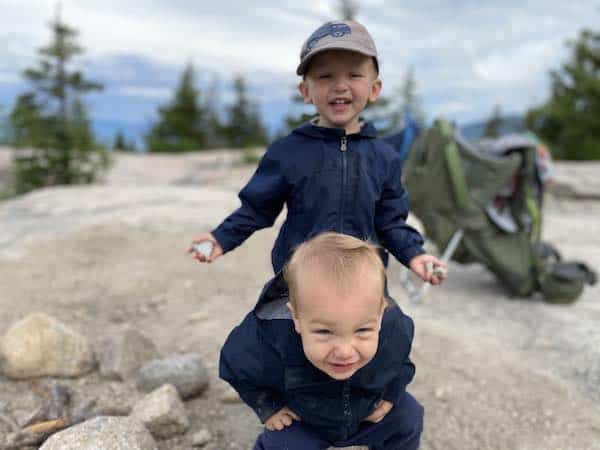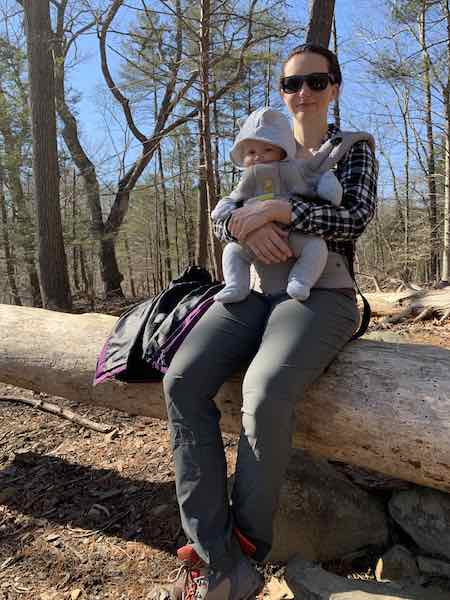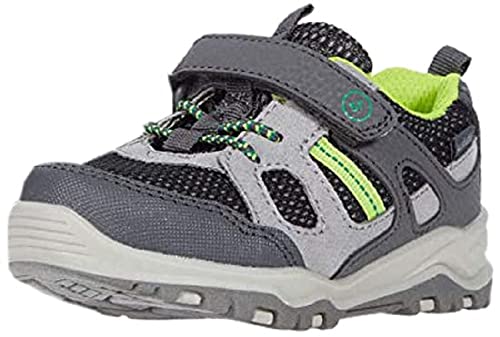How to Dress your Baby/Toddler for Hiking

Kristina
—Jul 29, 2021
A great day out hiking compared to an average day or not so great day might come down to how you dress your toddler or baby for hiking. Dressing them in dry warm clothes ensures they can soak up the experience without getting fussy about being cold or wet.

I take my two boys hiking constantly and the majority of our family vacations are hiking trips. It is important that I dress my toddlers in the right toddler hiking clothes; Happy Kids equal Happy Hiking!
Another fun thing my toddlers and I do together is journal our hikes with my interactive hiking journal. It is a great spot for us to relive our adventures and plan new ones!
By ensuring they are wearing the appropriate clothes it reduces the chances of them complaining because of being cold, hot or wet. Further ways to help your toddler enjoy hiking can be found with my 15 Tips To Get Your Toddler to Enjoy Hiking.
In this article:
- What to Do Before Hiking With a Baby or Toddler
- Main Layers for your Toddler/Baby for Hiking
- Toddler Hiking Pants
- Toddler Hiking Jackets
- Baby Hiking Jackets
- Winter Accessories - Toddler and Baby Gloves and Hats
- Best Toddler and Baby Hiking Shoes
- Do Toddlers Need Hiking Boots?
- Conclusion on How to Dress your Toddler or Baby for Hiking
Disclosure: Some of the links below are affiliate links. This means that, at zero cost to you, I will earn an affiliate commission if you click through the link and finalize a purchase. Rest assured all products I suggest are products I have bought or would buy based on personal experience or through my network of other mommas.
What to Do Before Hiking With a Baby or Toddler
The most important thing to do is always check the weather for where you are going hiking. Check what the temperature will be when you set off for your hike as well as later in the day. Take into account any elevation change, higher elevation will be colder and if there are exposed sections of your hike it might mean more wind.
Remember you will be hiking, but your baby or toddler will not be, so make sure they are dressed warmer than you. If it is going to be wet rain gear is best!
You can check out my other blogs on Hiking with Baby and Hiking with your Toddler for a full guide on hiking with your child.
Main Layers for your Toddler/Baby for Hiking
The main layers are the easiest when it is not too cold out. Dress your baby/toddler in comfortable clothing that you don't mind if they get dirty.
In winter or cold weather it is best for your baby or toddlers' first layer to not be made of cotton. Cotton absorbs moisture and pulls heat away. Merino wool is the best because of its ability to prevent conductive heat loss. It however is the most expensive.
Good alternatives to merino wool are traditional wool, nylon or polyester. These fabrics are breathable, water resistant and durable.
I do not live where it is going to be ridiculously cold, I live in northeast USA. I find polyester base layer to be sufficient for my toddlers on most winter hikes.
Main Base Layer for a Toddler
- Best Toddler Base Layer Above 50F: Not needed
- Best Affordable Toddler Base Layer Below 50F: Patagonia mid-weight leggings
- Best Overall Toddler Base Layer Below 50F: Iksplor Base Layers
In warm weather a pair of shorts and a T-shirt is perfect. In mild temperatures , above 50 F, a pair of hiking pants, warm socks and a long sleeve shirt to start.
For the winter months you will want to add on a base thermal layer. Stay away from cotton material. Cotton will absorb the moisture and not evaporate making for a very cold toddler.
The best in the market is 100% merino wool base layer. Merino Wool is breathable, absorbs moisture and evaporate, durable, smell resistant, quick drying and most important keep your toddler warm. However, merino wool is expansive.
An alternative to merino wool is polyester. Ideal for temperatures between 30-50F. My boys have Patagonia mid-weight leggings for their leg base layer. They are 100% recycled polyester and work as a great baseline as it will wick the moisture away and keep the warmth in.
If there is snow on the ground I would dress them in full snow attire.
Main Base Layer for a Baby Going on a Hike
- Best Baby Base Layer Above 50F: Basic Onesie
- Best Affordable Toddler Base Layer Below 50F: Hocosa Organic Merino Wool Baby Shirt
- Best Overall Toddler Base Layer Below 50F: Iksplor Baby Base Layers
For babies I always put them in a onesie first then add the layers from there. Babies have a tendency to have blowouts. Wearing a onesie helps keep the blow out contained. Just make sure you bring a spare onesie or two!
During warm months the onesie might be the only layer, with a pair or light pants or shorts. Since your baby is not sweating cotton is not a concern here.
In colder weather a onsie might be the first of many layers. For temperatures freezing and below I recommend merino wool onesies, not cotton! Cotton soaks up moisture and pulls warmth from the body.
On top of the onesie put on a warm comfy pair of pants, long-sleeve or sweater and thick wool socks. Again if it is freezing or below I would have fleece lined pants and sweatshirt.
Pro Tip: If you are going for a longer hike you should always bring a spare change of clothes and socks for your child (unless wearing water sandals). You never know if there will be a nice looking stream to play in or an accident along the way.
Your goal should be to always be prepared! If your toddler is unhappy your hike will suffer or be cut short!
Toddler Hiking Pants
- Best Cold Weather Toddler Hiking Pants: Oakiwear Toddler Trail and Rain Pants
- Best Summer Weather Hiking Pants: Columbia Silver Ridge Pull-On Pants

If the weather is wet or the trail muddy, toddler hiking pants are great! They go on over their normal pants providing another layer of warmth. Or hiking pants can be the only layer if the weather is warm enough, above 60 degrees F.
Hiking Pants allow your toddler to splash in mud and get dirty without worrying that they are ruining their pants. I use Oakiwear Trail and Rain Pants for toddlers in cold weather and love them! They are waterproof, easy to clean and durable.
In the summer months a toddler hiking pant is still useful. It protects your toddler from the sun's ray and foliage brushing up against them. In summer I want a lighter pant to keep my toddlers cool. I have them in Columbia Silver Ridge Pull-On Pant.
Toddler Hiking Jackets
- Best Toddler Jacket for temperatures 40-65F: Columbia Jackets
- Best Toddler Jacket for Rain/Wind Protection: Oaki Rain Wind Shell
- Best Toddler Jacket for temperatures below 40F: North Face Toddler Winter Jacket
All our hikes, outside of warm weather, I begin with fleece Columbia jackets. The jackets are fleece, well made, and perfect for temperatures from 40-65. The jackets come in all different colors and are true to size. Bonus, these jackets make great car jackets for the winter months.
Alternative to the Columbia jackets would be a hoodie or sweatshirt.

If the temperature outside is between 40-50 degrees F I often will put a windbreaker on top of their Columbia jacket to start the hike. Layering is key because as the weather warms up you can take off one of the layers and put them in your hiking backpack. If your child is only wearing a winter jacket and it gets warmer outside you don't have many options.
You want a windbreaker that doesn't have a large fleece built in so it can be used in all weather; for example, if it is raining and 70 the windbreaker will be great. For colder rainy days you can add the Columbia jacket underneath the windbreaker/water shell to add a layer of warmth.
Windbreakers are not pure rain jackets; they are water resistant. For hiking in wet conditions I would suggest a waterproof jacket. You can find my article on Best Rain Gear for Toddlers here.
Baby Hiking Jackets
- Best Baby Jacket for temperatures 40-65F: Fleece Bunting Outfit
- Best Baby Jacket for Rain/Wind Protection: Tuffo Baby Coverall
- Best Baby Jacket for temperatures below 40F: Columbia Baby Bunting
When your child is still a baby (less than 1 year old) I found one piece jackets the easiest for hiking. Before a child can stand on their own having them wear a jacket and pants means when you pick them up their midsection is often exposed.
What type of one piece jacket I put on my baby is temperature dependent. Temperatures 40 and below I dress my baby in a full bunting outfit, shown below. If extreme cold I would dress my baby in a full baby snow outfit.

For temperatures between 40-65 degrees F I use a one piece jacket made from fleece or cotton. I commonly had my babies in Carters one pieces like the one below. Babies grow very quickly and I found Carters to be a compromise between great price and quality. Your baby will most likely only fit one outfit for a couple months so no need to spend top dollar.

My 9 month old in Carter's one piece jacket, warm socks and winter hat
Temperatures below 40 degrees F I would dress my toddler/baby in snow gear. Snow gear is thicker and will provided added insulation to keep warm. Columbia Bunting outfit will make your little one warm and toasty as you hike!
Winter Accessories - Toddler and Baby Gloves and Hats
- Best Baby and Toddler Gloves: N'Ice Cap Mittens
- Best Baby and Toddler Hat: N'Ice Hat and Mitten Combo
Hats and gloves are a must on any colder hikes. This will keep your baby/toddler protected if the weather changes for the worse or you reach a more exposed section of the trail. The best way to keep the hands warm of a baby under a 18 months is to buy mittens with no thumbs. If your baby can take their mittens off easily they will and throw them on the trail.
The N'Ice Cap mittens I refer to are great and what I have my babies and toddlers use. Mittens sized 18 months and below automatically come thumbless while larger size mittens come with thumbs.
For a toddler approaching age 2 I recommend switching him/her to mittens with thumbs. My toddlers around this age would find it frustrating if they could not pick up sticks/rocks in thumbless mittens. This ended up with them taking the mittens off.
The hat and mitten set below from N'Ice Cap was a favorite last year. My youngest was around 7 months and wore the hat and mitten set everywhere. The gloves only got used when it was around freezing or below however the hat got used from about October all the way through March. (I live in PA for reference).
Best Toddler and Baby Hiking Shoes
Hiking shoes are dependent on the child's age.
Baby Hiking Shoe
When my kids were babies and not able to walk or stand I use Hudson baby fleece booties. Booties are easy to put on, snap closed and very difficult for my babies to take off. If the weather was cold you could add a layer of wool socks below the booties. Or in very cold temperatures my babies were in full bunting outfits which covered their feet.
In warmer weather my babies went barefoot, as long as the trail was shaded.
My philosophy isn't to spend money when I don't have to. A baby doesn't walk and therefore doesn't need fancy hiking shoes. Just something on their feet to keep them warm.


Best Toddler Hiking Shoes
- Best Flexible Toddler Hiking Shoe: Keen Chandler CNX Sneaker
- Best Lightweight Toddler Hiking Shoe: Merrell Trail Chaser Jr Hiking Sneaker
- Best Toddler Affordable Hiking Shoes: OshKosh bump toe shoe
- Best Runner-Up Toddler Hiking Shoes: Stride Rite 360
When your child is able to stand and walk around, shoes become more important. For dry hikes I like to put them in a sturdy hiking shoe. This is not their everyday shoe, but the shoe they wear when they will be out on a rocky trail to add more stability.


Their first pair of hiking shoes were OshKosh bump toe shoe. This shoe you can easily find in a younger toddler size. However, I did try out a different shoe when my toddler needed a new one, mostly because the OshKosh brand was sold out at the time. I bought a Stride Rite runnings shoe and have been very happy with this shoe as well.
When my toddlers started rock hopping a more flexible hiking shoe worked wonders. [Keen Chandler CNX](http://Similiar to the Keen hiking shoe is the Merrell Trail Chaser Jr Hiking Sneaker. This top toddler hiking shoe is lightweight and provides a bit more foot support than the Keen hiking shoe.) was the perfect flexible hiking shoe for gripping the rocks as my toddler explored.
Similiar to the Keen hiking shoe is the Merrell Trail Chaser Jr Hiking Sneaker. This top toddler hiking shoe is lightweight and provides a bit more foot support than the Keen hiking shoe.
Find out all the benefits of toddler hiking shoes with Best Toddler Hiking Shoes, Sandals and Boots.
Do Toddlers Need Hiking Boots?
No a toddler hiking boot is not necessary, but does have it's benefits. A hiking boot provides the same benefits of a toddler hiking shoe but also more ankle support. If your toddler has had any foot or ankle injuries a toddler hiking boot will help.
Toddler hiking boots have more added support, better tread and ankle and foot stability than a normal toddler shoe.
| Product | Category |
|---|---|
Best Overall Toddler Hiking Boots | |
Best Toddler Hiking Boots for Older Toddlers | |
Best Traditional Hiking Boots for Boys | |
Best Affordable Hiking Boots for Girls and Boys |
For a young toddler they are not hiking the more difficult terrain. In more difficult terrain my toddlers are carried in their Kelty PerfectFit Signature backpack. For these reason I am happy to save some money and stick with their hiking shoes, for now!
However, if your older toddler is hiking more rough terrain hiking boots might come in handy!
If you plan on hiking with your toddler in winter I would recommend snow boots. Both my toddler boys wear Northside Frosty Insulated Winter Snow boots and I highly recommend them. Read further on Best Toddler Snow Boots and Warm Winter Socks.
Best Toddler Water Shoes for Hiking
- Best Overall Toddler Hiking Sandal: Keen Newport Closed Toe Hiking Sandal
- Best Budget Toddler Hiking Sandal: Apakowa sandal
If the hike is going to involve water and warm temperatures I put my toddlers in hiking water sandals.
Apakowa hiking sandals work great for a young toddler. The sandal is built strong, they are not flimsy like normal sandals are and have grips on the bottom of the shoe for traction. Pure water shoes are slippery on the bottom and not meant to be used outside of a pool or water area. With Apakowa sandals, however, my toddlers can hike in them as well as play in the water with them!
For an older toddler I prefer the Keen Newport H2 Closed Toe hiking sandal. It costs more than Apakowa, but built with better quality that will uphold more abuse that an older toddler will give it.
My kids have never had issues with blisters and the adjustable straps lets you alter the fit to your toddler's foot. Water sandals are the only shoes my toddlers wear in the summertime, they even wear them to daycare everyday.
Read Toddler Water Sandals for more information on best water sandals for toddlers. ****I go through the differences of Apakowa vs Keen water sandal and more information to help you chose what is best for you.


Conclusion on How to Dress your Toddler or Baby for Hiking
Babies and Toddlers don't require much to go hiking, just ensure they are dressed for the season and you checked the weather ahead of time. To begin you most likely have all the clothes you will need in their closet already.
Overtime adding some toddler hiking gear can add excitement and anticipation to your hikes. My toddlers love their specific "hiking gear"!
The most important thing is to have fun! My toddlers absolutely love hiking with me and I am sure your kids will love hiking with you too!
Hope you found this helpful!























